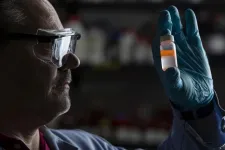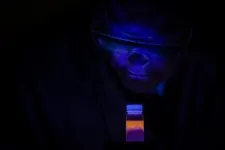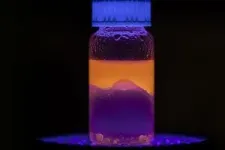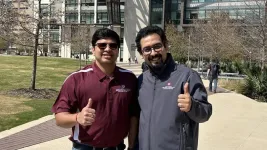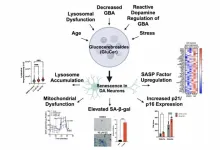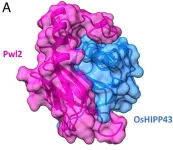(Press-News.org) COLUMBIA, Mo. — University of Missouri scientists are battling against an emerging enemy of human health: nanoplastics. Much smaller in size than the diameter of an average human hair, nanoplastics are invisible to the naked eye.
Linked to cardiovascular and respiratory diseases in people, nanoplastics continue to build up, largely unnoticed, in the world’s bodies of water. The challenge remains to develop a cost-effective solution to get rid of nanoplastics while leaving clean water behind.
That’s where Mizzou comes in. Recently, researchers at the university created a new liquid-based solution that eliminates more than 98% of these microscopic plastic particles from water.
“Nanoplastics can disrupt aquatic ecosystems and enter the food chain, posing risks to both wildlife and humans,” said Piyuni Ishtaweera, a recent alumna who led the study while earning her doctorate in nano and materials chemistry at Mizzou. “In layman’s terms, we’re developing better ways to remove contaminants such as nanoplastics from water.”
The innovative method — using water-repelling solvents made from natural ingredients — not only offers a practical solution to the pressing issue of nanoplastic pollution but also paves the way for further research and development in advanced water purification technologies.
“Our strategy uses a small amount of designer solvent to absorb plastic particles from a large volume of water,” said Gary Baker, an associate professor in Mizzou’s Department of Chemistry and the study’s corresponding author. “Currently, the capacity of these solvents is not well understood. In future work, we aim to determine the maximum capacity of the solvent. Additionally, we will explore methods to recycle the solvents, enabling their reuse multiple times if necessary.”
Initially, the solvent sits on the water’s surface the way oil floats on water. Once mixed with water and allowed to reseparate, the solvent floats back to the surface, carrying the nanoplastics within its molecular structure.
In the lab, the researchers simply use a pipette to remove the nanoplastic-laden solvent, leaving behind clean, plastic-free water. Baker said future studies will work to scale up the entire process so that it can be applied to larger bodies of water like lakes and, eventually, oceans.
Ishtaweera, who now works at the U.S. Food and Drug Administration in St. Louis, noted that the new method is effective in both fresh and saltwater.
“These solvents are made from safe, non-toxic components, and their ability to repel water prevents additional contamination of water sources, making them a highly sustainable solution,” she said. “From a scientific perspective, creating effective removal methods fosters innovation in filtration technologies, provides insights into nanomaterial behavior and supports the development of informed environmental policies.”
The Mizzou team tested five different sizes of polystyrene-based nanoplastics, a common type of plastic used in the making of Styrofoam cups. Their results outperformed previous studies that largely focused on just a single size of plastic particles.
“Nanoplastics extraction from water by hydrophobic deep eutectic solvents” was published in ACS Applied Engineering Materials. Additional co-authors are Mizzou’s Collen Ray, Wyland Filley and Garrett Cobb.
END
Mizzou scientists achieve more than 98% efficiency removing nanoplastics from water
The liquid-based solution uses a solvent to trap the plastic particles, leaving clean water behind.
2024-08-13
ELSE PRESS RELEASES FROM THIS DATE:
Electric scooter–related injuries are becoming more frequent and costly
2024-08-13
August 13, 2024 — The introduction of publicly shared electric scooters (“e-scooters”) in Denver, Colorado has resulted in a steady increase in injuries and hospital admissions, according to research led by Alexander Lauder, MD, an orthopedic surgeon at Denver Health Medical Center. The findings are presented in Clinical Orthopaedics and Related Research® (CORR®), a publication of The Association of Bone and Joint Surgeons®. The journal is published in the Lippincott portfolio by Wolters Kluwer.
"International ...
Children born prematurely fall into three groups
2024-08-13
About thirteen million babies each year are born prematurely, with preterm birth linked to increases in risk for attention-deficit/hyperactivity disorder (ADHD), problems with social development, and lower grades.
A problem with past analyses of prematurity, however, is that they do not capture the variety seen in children born pre-term, including some with outcomes better than the average results for full- term children. Pre-term means birth before 37 weeks of gestation, with full term being 40 weeks.
The tendency to lump preterm babies into one group hinders efforts to tailor care for any one child, researchers say. Now a new study, published online August 13 ...
Reducing operation qualification time and cost in additive manufacturing
2024-08-13
America Makes, the National Additive Manufacturing Innovation Institute, is supporting research to revolutionize the additive manufacturing (AM) industry by significantly reducing operational qualification time and cost.
The $2 million project, titled ACCELERATE, is led by Dr. Mohsen Taheri-Andani, an assistant professor in the J. Mike Walker ’66 Department of Mechanical Engineering at Texas A&M University. To secure the funding, Dr. Taheri-Andani partnered with Dr. Yash Parikh, a process engineering consultant at EOS who graduated with a doctorate in mechanical ...
Lipid accumulation drives cellular senescence in dopaminergic neurons
2024-08-13
"These findings align with our previous results in dopaminergic neurons in highlighting a central role for lipid accumulation in the senescence of DA neurons."
BUFFALO, NY- August 13, 2024 – A new research perspective was published in Aging (listed by MEDLINE/PubMed as "Aging (Albany NY)" and "Aging-US" by Web of Science), Volume 16, Issue 14 on July 19, 2024, entitled, “Lipid accumulation drives cellular senescence in dopaminergic neurons.”
As highlighted in the Abstract of this perspective, Parkinson’s disease (PD) is an age-related movement disorder caused ...
The Hastings Center awarded $1.5 million by PCORI to study organizational trustworthiness and community-engaged research
2024-08-13
A research team at The Hastings Center has been approved for $1.5 million in funding by the Patient-Centered Outcomes Research Institute (PCORI) to study organizational trustworthiness as it relates to community-engaged research. Led by Virginia A. Brown, PhD, a research scholar at The Hastings Center, the study will be the first to investigate the role of organizational trustworthiness in shaping research engagement processes and outcomes.
Measures to assess organizational trustworthiness as it relates to research ...
Dairy nutrition is leading the sustainability charge
2024-08-13
Philadelphia, August 13, 2024 – Research into reducing greenhouse gas emissions from livestock has increased exponentially as the dairy and agriculture sectors work together toward shared sustainability and efficiency goals. While this progress has been made in all areas of dairy science research, from genetics to animal health and welfare, dairy nutrition has emerged as a particularly impactful area for emission reduction. In a new invited review in the Journal of Dairy Science, a preeminent voice in sustainability and dairy nutrition synthesizes ...
A new method for protection from plant pathogens could help support global food security.
2024-08-13
By modifying a plant intracellular immune receptor (NLR), researchers have developed a potential new strategy for resistance to rice blast disease, one of the most important diseases threatening global food security. The collaborative team from the UK and Japan have recently published their research in PNAS. This could have implications for future approaches to crop protection and ultimately global food supply stability.
The research was led from the Department of Biochemistry and Metabolism at the John Innes Centre, with partners at The Sainsbury Laboratory, University of East Anglia, and the Division of Genomics and Breeding, Iwate Biotechnology Research Center, Japan. For a ...
Halogen bonding for selective electrochemical separation, path to sustainable chemical processing demonstrated
2024-08-13
With a new polymer that only attracts certain substances from solutions when electrically activated, researchers have taken a major step towards sustainable chemical separation.
A team based at the University of Illinois Urbana-Champaign has reported the first demonstration of selective electrochemical separation driven by halogen bonding in the journal JACS Au. This was achieved by engineering a polymer that modulates the charge density on a halogen atom when electricity is applied. The polymer then attracts only certain targets – such as halides, oxyanions, and even organic molecules – from organic solutions, ...
Study reveals urban trees suffer more from heat waves and drought than their rural counterparts
2024-08-13
NEW YORK, August 13, 2024 — A recently published study in Ecological Applications details how trees in New York City and Boston are more negatively impacted by heat waves and drought than trees of the same species in nearby rural forests. The finding, made by researchers at the Advanced Science Research Center at the CUNY Graduate Center (CUNY ASRC), highlights the challenges urban trees face in the context of climate change and underscores the importance of tailored urban forestry management as ...
New $7.7 million grant to propel search for medications for brain disorders
2024-08-13
JUPITER, Fla. — Children born with a damaged gene needed for healthy brain development, SYNGAP1, experience seizures, sensory processing disorders, difficulty speaking, intellectual disability, and autism-like behaviors. It’s a condition without any treatments, one that’s hard both on parents and children, said Gavin Rumbaugh, Ph.D., a neuroscientist at The Herbert Wertheim UF Scripps Institute for Biomedical Innovation & Technology.
Rumbaugh and a team of scientists from the institute have been awarded a five-year grant from the National Institute of Mental Health worth $7.7 million to work toward a treatment. Their goal is to ...
LAST 30 PRESS RELEASES:
Boosting the cell’s own cleanup
Movement matters: Light activity led to better survival in diabetes, heart, kidney disease
Method developed to identify best treatment combinations for glioblastoma based on unique cellular targets
Self-guided behavioral app helps children with epilepsy sleep earlier
Higher consumption of food preservatives is associated with an increased risk of type 2 diabetes
NTU Singapore-led team captures first-ever ‘twitch’ of the eye’s night-vision cells as they detect light, paving the way for earlier detection of blindness-causing diseases
Global aviation emissions could be halved through maximising efficiency gains, new study shows
Fewer layovers, better-connected airports, more firm growth
Exposure to natural light improves metabolic health
As we age, immune cells protect the spinal cord
New expert guidance urges caution before surgery for patients with treatment-resistant constipation
Solar hydrogen can now be produced efficiently without the scarce metal platinum
Sleeping in on weekends may help boost teens’ mental health
Study: Teens use cellphones for an hour a day at school
After more than two years of war, Palestinian children are hungry, denied education and “like the living dead”
The untold story of life with Prader-Willi syndrome - according to the siblings who live it
How the parasite that ‘gave up sex’ found more hosts – and why its victory won’t last
When is it time to jump? The boiling frog problem of AI use in physics education
Twitter data reveals partisan divide in understanding why pollen season's getting worse
AI is quick but risky for updating old software
Revolutionizing biosecurity: new multi-omics framework to transform invasive species management
From ancient herb to modern medicine: new review unveils the multi-targeted healing potential of Borago officinalis
Building a global scientific community: Biological Diversity Journal announces dual recruitment of Editorial Board and Youth Editorial Board members
Microbes that break down antibiotics help protect ecosystems under drug pollution
Smart biochar that remembers pollutants offers a new way to clean water and recycle biomass
Rice genes matter more than domestication in shaping plant microbiomes
Ticking time bomb: Some farmers report as many as 70 tick encounters over a 6-month period
Turning garden and crop waste into plastics
Scientists discover ‘platypus galaxies’ in the early universe
Seeing thyroid cancer in a new light: when AI meets label-free imaging in the operating room
[Press-News.org] Mizzou scientists achieve more than 98% efficiency removing nanoplastics from waterThe liquid-based solution uses a solvent to trap the plastic particles, leaving clean water behind.
